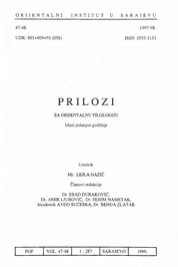KONFESIONALNI SASTAV STANOVNIŠTVA U BOSNI I HERCEGOVINI U PRVIM STOLJEĆIMA OSMANSKE VLADAVINE
RELIGIOUS STRUCTURE OF BOSNIA’S POPULATION IN THE FIRST CENTURIES OF THE OTTOMAN RULE
Author(s): Adem HandžićSubject(s): Christian Theology and Religion, Jewish studies, History of Church(es), Social history, Islam studies, Culture and social structure , 13th to 14th Centuries, 15th Century, The Ottoman Empire, History of Religion
Published by: Orijentalni Institut u Sarajevu
Keywords: Bosnia's population; First Centuries of the Ottoman rule; Religious structure of the population; Church history; Church of Bosnia; 14th-15th centuries; Islam in Bosnia; Christians and Jews;
Summary/Abstract: This is a review of the religious structure of the population as no other differences were manifested at that time, nor in the Middle Ages. In official Ottoman censuses all the inhabitants of all social classes were registered only as "Bosnians" who spoke the Bosnian language. This makes it clear that the Ottoman authority recognized that the Slavic people were specific although by setting up towns it tried to develop its own culture and strengthen its powering that territory. The followers of the teaching of the so-called "Church of Bosnia", which spread here from the beginning of the 13th century until the mid-15th century and was condemned as heresy, suffered brutal persecution by the Catholic Church. The struggle was waged by the Franciscans. They built their first church in 1340, and by the middle of the 15th century they had built 13 Catholic churches in Central and north-eastern Bosnia (Fojnica, Kreševo, Sutjeska, Visoko, Vranduk, then Srebrenica, Zvomik, Olovo, Bijeljina, Gornja Tuzla, Donja Tuzla, Modriča and Tešanj). So the Ottoman authorities found (1463) few followers of the "Church of Bosnia" in Bosnia. According to some scientists, its teaching never abandoned the scope of Christian orthodoxy, but it only represented particular Christian teaching in the local language. It was more a manifestation of rebellion against social injustice than it was a separate religion. It resisted both Byzantinization and Latinization of the South-Slavic countries. Particularly brutal mass persecutions of the "Christians" (krstjani), as they called themselves, took place in the last decade of the Bosnian State’s existence. Obviously those were the reasons why Sultan Mehmed II had an unexpected meeting with a congregation near Jajce when a larger group of people expressed their subservience to him. Moreover, they adopted Islam.
Journal: Prilozi za orijentalnu filologiju
- Issue Year: 1995
- Issue No: 42-43
- Page Range: 119-153
- Page Count: 35
- Language: Bosnian

